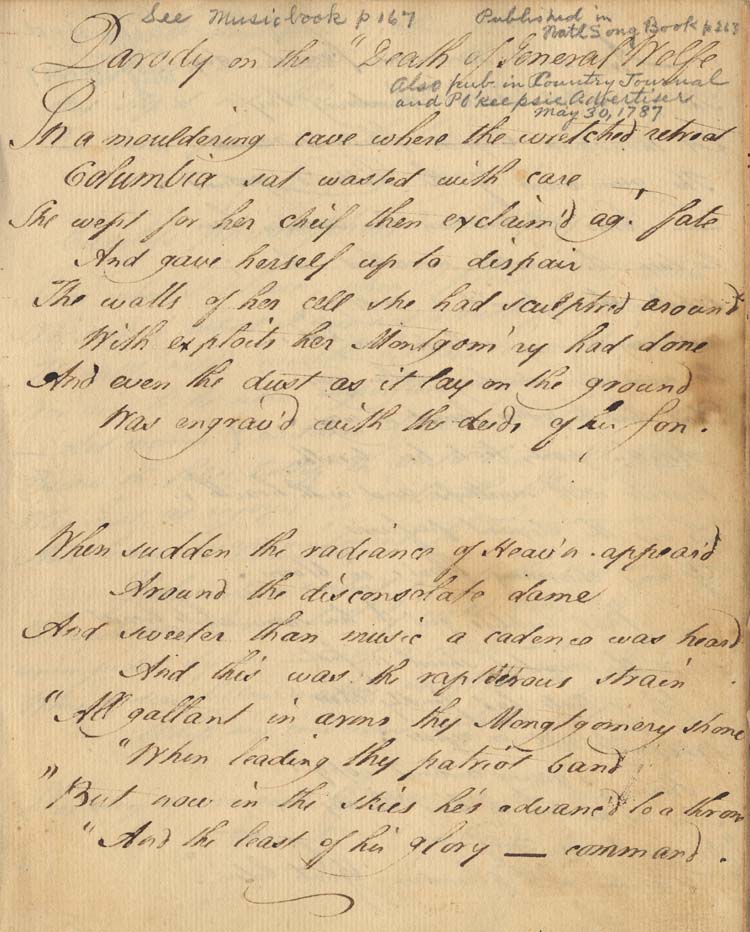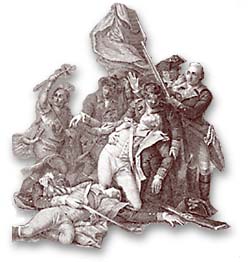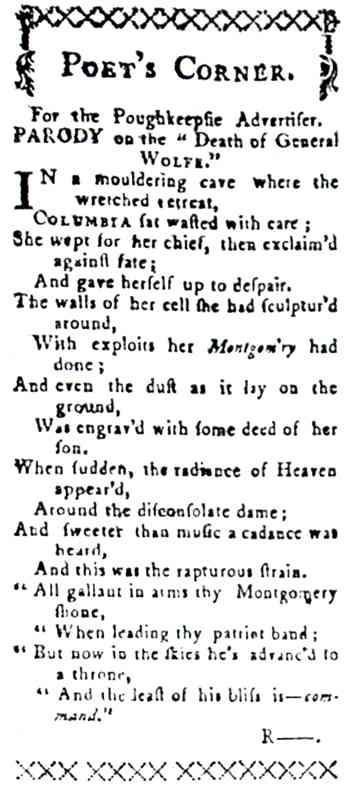 |
|
|
 |
|
|

|

| |
|
| ||

Country Journal and Poughkeepsie Advertiser Aug 15, 1787 |
|

|

| Listen to Midi |
|
The Twentieth Century Biographical Dictionary of Notable Americans: Volume VII MONTGOMERY, Richard, Revolutionary soldier, was born at Convoy House, near Raphoe, county Donegal, Ireland, Dec. 2, 1736; son of Thomas Montgomery, a member of the British parliament from Lifford. He was graduated from Trinity college, Dublin, and entered the 17th regiment of foot as ensign, Aug. 21, 1756. His regiment was ordered to Halifax, N.S., and he took part in the siege of Louisburg under Gen. James Wolfe in 1758. He was promoted lieutenant for his bravery on this occasion, and in 1759 he joined the expedition under Sir Jeffrey Amherst to relieve General Abercrombie. He served in the command of Colonel Haviland in the capture of Fort Ticonderoga in July, Crown Point in August, and Montreal, Sept. 7, 1759; was promoted adjutant, May 15, 1760, ordered to the West Indies in 1762, was commissioned captain, May 5, 1762, and took part in the campaign against Martinique and Havana. He returned to New York, and at the close of the war with France in 1763, received permission to return to England, where he resided until 1773, when he became embittered, as his claims for military advancement were neglected. As a result he sold his commission in the army, returned to America in 1773, and purchased a farm of sixty acres at King's Bridge, Westchester county, N.Y. He was married July 24, 1773, to Janet, daughter of Judge Robert R. and Margaret (Beckman) Livingston and removed to Rhinebeck, N.Y., where he resided until he joined the Continental army. He was a delegate to the let Provincial congress held in New York city in May, 1775, and in June, 1775, was commissioned one of eight brigadier-generals in the Continental army and became second in command to Gen. Philip Schuyler. He left Rhinebeck with his wife and her brother, Edward Livingston (q.v.), then a mere lad, and they made the journey in a coach to the residence of Gen. Philip Schuyler at Saratoga where he parted with his wife with the assurance "that she would never have cause to blush for her Montgomery." On account of the disability of General Schuyler, Montgomery was placed in command of the expedition to Canada. The invasion was undertaken without proper preparation and its movements were controlled chiefly by circumstances. He proceeded by way of Whitehall, and after many hardships reached Ticonderoga where he learned that Sir Guy Carleton was organizing a naval force on Lake Champlain to prevent the Americans from[p.421] crossing the St. Lawrence. Montgomery took possession of the Isle aux Noix on Lake Champlain, and with 1000 men laid siege to St. Johns and Chambly, which surrendered to him, and advanced toward Montreal, which capitulated, Nov. 12, 1775, and for this victory he was made major-general by congress. By the capture of Montreal he obtained possession of all the military stores in the town, and of eleven vessels in the harbor, General Carleton having with great difficulty retreated to Quebec. The central object of the expedition now only remained; as Montgomery wrote in a letter to his father-in-law, Robert R. Livingston, "until Quebec is taken, Canada is unconquered." He effected a junction with Arnold, who had a force of 700 men, before the walls of Quebec, Dec, 3, 1775. The combined attack was made on both sides of the place, Dec. 31, 1775, Montgomery leading his little force of 500 men in the midst of a heavy snow-storm. The first barrier, Près de Ville under Cape Diamond, was carried, and Montgomery at their head shouted "Men of New York, you will not fear to follow where your general leads!" The little army pushed forward. In the windows of a house which overlooked the second barrier, two cannon had been placed, which, upon Montgomery's appearance on a little rising ground, were discharged. Montgomery and his two aids, McPherson and Captain Chessman, being in advance, were instantly killed. His soldiers with those of Arnold became at once demoralized and the British troops pursued the defeated army from the cityand captured about 400 men.Montgomery's body was found partly covered by the snow and the British commander ordered him buried within the walls surrounding the powder magazine, and accorded the body the honor of a military burial. After reposing for forty-two years, his remains were removed at the request of the legislature of the state of New York to New York city and interred in St. Paul's chapel churchyard. The journey from Quebec to New York was attended by civic honors, notably at Albany, July 4, 1818, and on the voyage down the Hudson on the steamer Richmond, passing Montgomery Place, the home of the widow, who viewed the vessel from the portico. The death of Montgomery was deeply felt by friend and foe, and congress proclaimed its "grateful remembrance, respect and high veneration." The city of New York erected a monument under the portico of St. Paul's chapel on the Broadway front. A tablet was also erected upon the spot where he fell at Quebec, by the Sons of the American Revolution in 1901. Mrs. Montgomery survived her husband for fifty-two years and after completing the home commenced by the general in 1774 at Rhinebeck Flats, known as the "Rhinebeck Place," removed to the immediate east bank of the Hudson above Barrytown, where she erected "Montgomery Place" which continued to be her home up to the time of her death in November, 1827. General Montgomery died at Quebec, Canada, Dec. 31, 1775.
|

![]() Copyright © 2003, InterMedia Enterprises
Copyright © 2003, InterMedia Enterprises